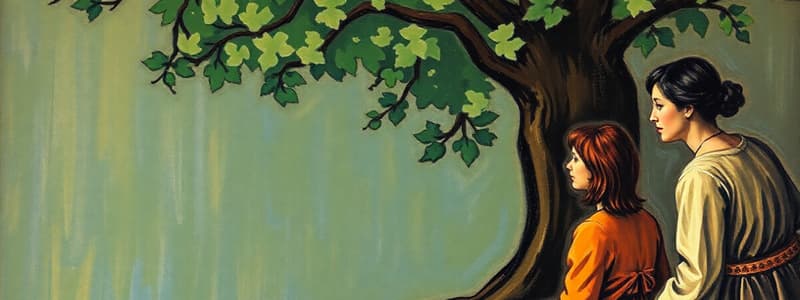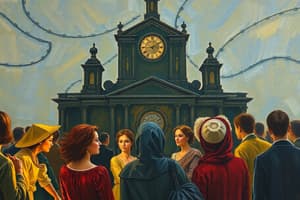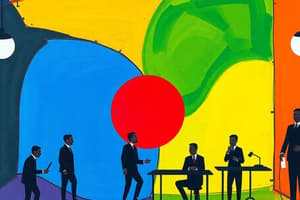Podcast
Questions and Answers
According to Schein, which element of organizational culture is considered the foundation from which other elements emerge?
According to Schein, which element of organizational culture is considered the foundation from which other elements emerge?
- Rules
- Values
- Behaviours
- Basic assumptions (correct)
Organizational culture is static and rarely changes over time.
Organizational culture is static and rarely changes over time.
False (B)
Provide an example of how a group's responses to internal and external challenges can shape their organizational culture.
Provide an example of how a group's responses to internal and external challenges can shape their organizational culture.
The rise of remote work during the COVID-19 pandemic led to a shift in organizational culture, with many companies adopting virtual collaboration tools and flexible work arrangements.
Newcomers to an organization learn the existing ______ and ______ through a process of socialization.
Newcomers to an organization learn the existing ______ and ______ through a process of socialization.
What aspect of culture does Schein emphasize as being shaped by a group's responses to challenges?
What aspect of culture does Schein emphasize as being shaped by a group's responses to challenges?
Basic assumptions within an organization can be easily altered according to the preferences of its members.
Basic assumptions within an organization can be easily altered according to the preferences of its members.
What do newcomers learn through the process of socialization within an organization?
What do newcomers learn through the process of socialization within an organization?
Schein defines culture as a set of basic ______ that are enduring and not easily changed.
Schein defines culture as a set of basic ______ that are enduring and not easily changed.
Match the following elements of organizational culture with their descriptions:
Match the following elements of organizational culture with their descriptions:
Which of the following is NOT a key component of a 'strong culture' according to Deal and Kennedy?
Which of the following is NOT a key component of a 'strong culture' according to Deal and Kennedy?
The concept of organizational culture was initially met with skepticism from both academics and practitioners.
The concept of organizational culture was initially met with skepticism from both academics and practitioners.
What are two ways of thinking about culture in an organization?
What are two ways of thinking about culture in an organization?
Deal and Kennedy's concept of 'strong cultures' emphasizes the importance of ______ for achieving business success.
Deal and Kennedy's concept of 'strong cultures' emphasizes the importance of ______ for achieving business success.
Match each organizational culture concept with its corresponding example:
Match each organizational culture concept with its corresponding example:
Peters and Waterman identified "themes" that characterized the cultures of "excellent" companies by studying a small number of companies.
Peters and Waterman identified "themes" that characterized the cultures of "excellent" companies by studying a small number of companies.
Explain the difference between Deal and Kennedy's 'strong cultures' and Peters and Waterman's 'excellent cultures.'
Explain the difference between Deal and Kennedy's 'strong cultures' and Peters and Waterman's 'excellent cultures.'
What aspect of organisational culture does Peters and Waterman focus on?
What aspect of organisational culture does Peters and Waterman focus on?
Organisational culture is solely a fixed entity that remains unchanged over time.
Organisational culture is solely a fixed entity that remains unchanged over time.
Who is the author of a key model that helps understand organisational culture?
Who is the author of a key model that helps understand organisational culture?
Organisational culture is created through the interaction of ________ members.
Organisational culture is created through the interaction of ________ members.
Match the following scholars with their contributions to the study of organisational culture:
Match the following scholars with their contributions to the study of organisational culture:
Which of the following is NOT a characteristic of cultural performances as defined in the content?
Which of the following is NOT a characteristic of cultural performances as defined in the content?
All members of an organisation share a uniform culture.
All members of an organisation share a uniform culture.
What does the term 'markers' refer to in the context of organisational culture?
What does the term 'markers' refer to in the context of organisational culture?
The ________ perspective highlights the ambiguity and complexity of organisational cultures.
The ________ perspective highlights the ambiguity and complexity of organisational cultures.
Which cultural indicator focuses on the stories told within an organisation?
Which cultural indicator focuses on the stories told within an organisation?
According to Pacanowsky and O'Donnell-Trijillo, culture is best understood through communication processes.
According to Pacanowsky and O'Donnell-Trijillo, culture is best understood through communication processes.
What can the study of subcultures within an organisation reveal?
What can the study of subcultures within an organisation reveal?
Schein defines culture as a pattern of shared basic assumptions that the group learned as it solved problems of ________ and ________.
Schein defines culture as a pattern of shared basic assumptions that the group learned as it solved problems of ________ and ________.
Which term describes the coexistence of different cultures within an organization?
Which term describes the coexistence of different cultures within an organization?
What is the primary failure of earlier prescriptive works on organisational culture?
What is the primary failure of earlier prescriptive works on organisational culture?
Match the following terms with their descriptions:
Match the following terms with their descriptions:
Flashcards
Organisational Culture
Organisational Culture
The shared assumptions, values, behaviours, and artifacts in an organization.
Culture as possession
Culture as possession
The idea that organizations can adopt a specific culture that influences their success.
Culture as identity
Culture as identity
Conceptualizes culture as the core essence of what an organization represents.
Strong Culture
Strong Culture
Signup and view all the flashcards
Key components of strong culture
Key components of strong culture
Signup and view all the flashcards
Values
Values
Signup and view all the flashcards
Heroes in culture
Heroes in culture
Signup and view all the flashcards
Excellent Cultures
Excellent Cultures
Signup and view all the flashcards
Basic Assumptions
Basic Assumptions
Signup and view all the flashcards
Emergent Process
Emergent Process
Signup and view all the flashcards
Cultural Socialization
Cultural Socialization
Signup and view all the flashcards
Cultural Evolution
Cultural Evolution
Signup and view all the flashcards
Intangible Aspects
Intangible Aspects
Signup and view all the flashcards
Prescriptive vs. Descriptive
Prescriptive vs. Descriptive
Signup and view all the flashcards
Shared Culture Myth
Shared Culture Myth
Signup and view all the flashcards
Cultural Markers
Cultural Markers
Signup and view all the flashcards
Emergent Culture
Emergent Culture
Signup and view all the flashcards
Cultural Performances
Cultural Performances
Signup and view all the flashcards
Subcultures
Subcultures
Signup and view all the flashcards
Fragmentation Perspective
Fragmentation Perspective
Signup and view all the flashcards
Schein’s Definition of Culture
Schein’s Definition of Culture
Signup and view all the flashcards
Communication as Culture
Communication as Culture
Signup and view all the flashcards
Power Dynamics in Culture
Power Dynamics in Culture
Signup and view all the flashcards
Performative Nature of Culture
Performative Nature of Culture
Signup and view all the flashcards
Customer-Centric Values
Customer-Centric Values
Signup and view all the flashcards
Bias for Action
Bias for Action
Signup and view all the flashcards
Study Notes
Organisational Culture: Key Concepts
- Organisations are viewed as cultures, drawing from anthropological perspectives. Each organisation has unique ways of operating and communicating.
- Culture can be viewed as both something an organisation has (a specific type that can impact success) and something an organisation is (an intrinsic aspect).
- Schein's model defines culture as shared assumptions, values, behaviors, and artifacts, developed as organisations adapt.
Prescriptive Views of Culture
- The "culture" metaphor resonated with both academics and practitioners. It viewed organisations as arenas of stories and values, not just rational institutions.
- Culture became a commonplace topic of discussion.
Strong Cultures (Deal & Kennedy)
- Strong cultures can boost business success.
- Key elements of a strong culture include:
- Values: Beliefs and visions held by members (e.g., innovation, stability).
- Heroes: Individuals embodying values (e.g., Steve Jobs at Apple).
- Rites and Rituals: Ceremonies celebrating values.
- Cultural Network: Communication system reinforcing values.
Excellent Cultures (Peters & Waterman)
- Peters and Waterman studied highly successful companies to identify cultural themes.
- Their work influenced organizational practices by emphasizing intangible aspects like values and heroes.
- However, their prescriptive approach to management was criticized for oversimplifying culture and assuming a shared, fixed culture.
Organisational Cultures are Complicated
- Organizational culture is multifaceted, with various "markers" for study.
- Examples include rites (renewal, passage), ceremonies, values/beliefs, employee metaphors, stories, informal conversations.
- Scholars may examine individual markers or their interactions.
Organisational Cultures are Emergent
- Cultures are socially created through member interactions.
- Communication is both a product and a producer of culture.
- Communication processes are best understood as performances that are interactive, contextual, episodic, and improvisational.
Organisational Cultures are Not Unitary
- Organisations have multiple, coexisting subcultures.
- Subcultures may emerge from different areas, hierarchical levels, or personal networks. These subcultures can reflect different interests and power dynamics.
Organisational Cultures are Often Ambiguous
- Organisational culture is often fragmented and ambiguous.
- Understanding culture is complex in today's fast-paced world.
- Multiple realities and varied cultural interpretations are common.
Schein's Model of Organisational Culture
- Edgar Schein's model offers a framework for understanding organizational culture.
- Culture is defined as a pattern of shared basic assumptions learned through problem-solving.
- Culture is collective, not individual and manifests at different scales.
- Culture fulfills a human need for stability and meaning, promoting integration.
Schein's Model Continued
- Culture is enduring and often unconscious to members.
- It comprises values, behaviours, rules, and artifacts (visible), with basic assumptions as the foundation.
- Culture emerges from group responses to internal and external challenges (shaped by experience).
- Culture socializes newcomers, while newcomers also influence the culture.
Studying That Suits You
Use AI to generate personalized quizzes and flashcards to suit your learning preferences.




